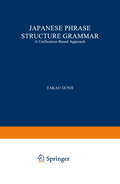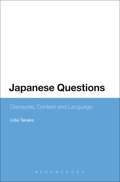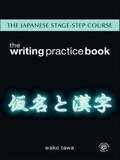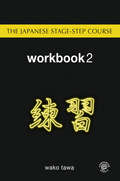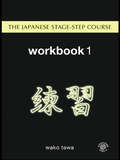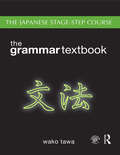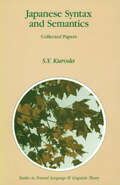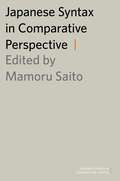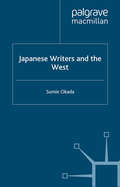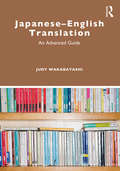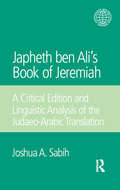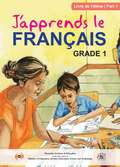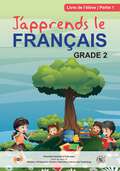- Table View
- List View
Japanese Phrase Structure Grammar: A Unification-based Approach (Studies in Natural Language and Linguistic Theory #8)
by T. GunjiThis book is a considerable revision and extension of my thesis for The Ohio State University completed in 1981: A Phrase Structural Analysis of the Japanese Language (Gunji 1981a). The book discusses some of the major grammatical constructions of Japanese in a version of phrase structure grammar called Japanese Phrase Structure Grammar (JPSG), which is loosely based on such frameworks for phrase structure grammar as Generalized Phrase Structure Grammar (GPSG) and Head-driven Phrase Structure Grammar (HPSG). Particular emphasis is placed on the binding and control of pronouns (both implicit - "zero" - and explicit ones, including reflexives) in complementation structures (chapter 4) and adjunction structures (chapter 5). Even though this book started as a revision of my 1981 thesis, the resultant book has few traces of my thinking then. The 1981 thesis was closely related to an early version of GPSG, which was then at a very preliminary stage, and I had only a few preprints of papers by Gerald Gazdar and others to read. GPSG itself has evolved during the past. several years, culminating in a book published last year (Gazdar, Klein, Pullum, and Sag 1985), which differs from the early theory in many ways.
Japanese Questions: Discourse, Context and Language
by Lidia TanakaQuestions and interrogatives in Japanese discourse have attracted considerable interest from grammarians, but the communicative aspect has received little attention. This book fills this gap. Through detailed analyses of formal and informal interactions, this book demonstrates that the inherent multi-functional and polysemous aspect of language can also be observed in the use of questions. What emerges is a sense of the considerable variety of question forms and also an understanding of how questions are used to perform a wide range of social actions.The importance of context is stressed throughout the book; both in guiding the speakers' choices of question types and in helping to create the particular stance that characterizes those interactions.The data used in this book shows that speakers prefer questions that are not canonical. When speakers do use canonical questions, these are overwhelmingly accompanied by some mollifiers. This phenomenon suggests that in Japanese communication the illocutionary force of canonical questions is too strong. To soften the interaction, speakers tend to use other types of interrogative forms such as statements with rising intonation or, at least, to leave questions grammatically unfinished. The findings in this book contribute to the understanding of how Japanese speakers use questions in different communicative interactions and provide new evidence of the gap between prescriptive grammar and actual communication.
Japanese Questions: Discourse, Context And Language
by Lidia TanakaQuestions and interrogatives in Japanese discourse have attracted considerable interest from grammarians, but the communicative aspect has received little attention. This book fills this gap. Through detailed analyses of formal and informal interactions, this book demonstrates that the inherent multi-functional and polysemous aspect of language can also be observed in the use of questions. What emerges is a sense of the considerable variety of question forms and also an understanding of how questions are used to perform a wide range of social actions.The importance of context is stressed throughout the book; both in guiding the speakers' choices of question types and in helping to create the particular stance that characterizes those interactions.The data used in this book shows that speakers prefer questions that are not canonical. When speakers do use canonical questions, these are overwhelmingly accompanied by some mollifiers. This phenomenon suggests that in Japanese communication the illocutionary force of canonical questions is too strong. To soften the interaction, speakers tend to use other types of interrogative forms such as statements with rising intonation or, at least, to leave questions grammatically unfinished. The findings in this book contribute to the understanding of how Japanese speakers use questions in different communicative interactions and provide new evidence of the gap between prescriptive grammar and actual communication.
Japanese Sentence Processing
by Reiko Mazuka Noriko NagaiThis volume is a direct result of the International Symposium on Japanese Sentence Processing held at Duke University. The symposium provided the first opportunity for researchers in three disciplinary areas from both Japan and the United States to participate in a conference where they could discuss issues concerning Japanese syntactic processing. The goals of the symposium were three-fold: * to illuminate the mechanisms of Japanese sentence processing from the viewpoints of linguistics, psycholinguistics and computer science; * to synthesize findings about the mechanisms of Japanese sentence processing by researchers in these three fields in Japan and the United States; * to lay foundations for future interdisciplinary research in Japanese sentence processing, as well as international collaborations between researchers in Japan and the United States. The chapters in this volume have been written from the points of view of three different disciplines, with various immediate objectives -- from building usable speech understanding systems to investigating the nature of competence grammars for natural languages. All of the papers share the long term goal of understanding the nature of human language processing mechanisms. The book is concerned with two central issues -- the universality of language processing mechanisms, and the nature of the relation between the components of linguistic knowledge and language processing. This volume demonstrates that interdisciplinary research can be fruitful, and provides groundwork for further research in Japanese sentence processing.
Japanese Sentence Processing
by Reiko Mazuka Noriko NagaiThis volume is a direct result of the International Symposium on Japanese Sentence Processing held at Duke University. The symposium provided the first opportunity for researchers in three disciplinary areas from both Japan and the United States to participate in a conference where they could discuss issues concerning Japanese syntactic processing. The goals of the symposium were three-fold: * to illuminate the mechanisms of Japanese sentence processing from the viewpoints of linguistics, psycholinguistics and computer science; * to synthesize findings about the mechanisms of Japanese sentence processing by researchers in these three fields in Japan and the United States; * to lay foundations for future interdisciplinary research in Japanese sentence processing, as well as international collaborations between researchers in Japan and the United States. The chapters in this volume have been written from the points of view of three different disciplines, with various immediate objectives -- from building usable speech understanding systems to investigating the nature of competence grammars for natural languages. All of the papers share the long term goal of understanding the nature of human language processing mechanisms. The book is concerned with two central issues -- the universality of language processing mechanisms, and the nature of the relation between the components of linguistic knowledge and language processing. This volume demonstrates that interdisciplinary research can be fruitful, and provides groundwork for further research in Japanese sentence processing.
The Japanese Shakespeare: Language and Context in the Translations of Tsubouchi Shōyō (ISSN)
by Daniel GallimoreOffering the first book-length study in English on Tsubouchi and Shakespeare, Gallimore offers an overview of the theory and practice of Tsubouchi’s Shakespeare translation and argues for Tsubouchi’s place as "the Japanese Shakespeare." Shakespeare translation is one of the achievements of modern Japanese culture, and no one is more associated with that achievement than the writer and scholar Tsubouchi Shōyō (1859–1935). This book looks at how Tsubouchi received Shakespeare in the context of his native literature and his strategies for bridging the gaps between Shakespeare’s rhetoric and his developing language. Offering a significant contribution to the field of global Shakespeare and literary translation, Gallimore explores dominant stylistic features of the early twentieth-century Shakespeare translations of Tsubouchi and analyses the translations within larger linguistic, historical, and cultural traditions in local Japanese, universal Chinese, and spiritual Western elements. This book will appeal to any student, researcher, or scholar of literary translation, particularly those interested in the complexities of Shakespeare in translation and Japanese language, culture, and society.
The Japanese Shakespeare: Language and Context in the Translations of Tsubouchi Shōyō (ISSN)
by Daniel GallimoreOffering the first book-length study in English on Tsubouchi and Shakespeare, Gallimore offers an overview of the theory and practice of Tsubouchi’s Shakespeare translation and argues for Tsubouchi’s place as "the Japanese Shakespeare." Shakespeare translation is one of the achievements of modern Japanese culture, and no one is more associated with that achievement than the writer and scholar Tsubouchi Shōyō (1859–1935). This book looks at how Tsubouchi received Shakespeare in the context of his native literature and his strategies for bridging the gaps between Shakespeare’s rhetoric and his developing language. Offering a significant contribution to the field of global Shakespeare and literary translation, Gallimore explores dominant stylistic features of the early twentieth-century Shakespeare translations of Tsubouchi and analyses the translations within larger linguistic, historical, and cultural traditions in local Japanese, universal Chinese, and spiritual Western elements. This book will appeal to any student, researcher, or scholar of literary translation, particularly those interested in the complexities of Shakespeare in translation and Japanese language, culture, and society.
Japanese Stage-Step Course: Writing Practice Book
by Wako TawaThe Writing Practice Book provides a step-by-step guide to writing Kana and Kanji. It is designed to give maximum flexibility to users of The Japanese Stage-Step Course and enables students to learn, practice and perfect their writing skills at their own pace. The book is divided into two parts; the first focuses on Kana and the second on Kanji. There are clear instructions on stroke order followed by tracing exercises and plenty of boxes are provided for additional practice. Kanji are gradually introduced in sets and are accompanied by the Japanese readings, examples of usage and radicals.
The Japanese Stage-Step Course: Workbook 2
by Wako TawaWorkbook 2 of the Japanese Stage-Step Course is designed to be used alongside Stages Two and Three of the Grammar Textbook. It contains conversation, listening, reading and writing exercises along with new vocabulary for each lesson in the textbook to enable students to thoroughly practice the grammatical structures they have learnt. Additional features include: detailed explanation of vocabulary items abundant exercises including sentence as well as discourse practices extensive cross-referencing with the Grammar Textbook Japanese–English and English–Japanese glossary. All the audio material for Workbook 2 is available on CD2.
The Japanese Stage-Step Course: Workbook 2
by Wako TawaWorkbook 2 of the Japanese Stage-Step Course is designed to be used alongside Stages Two and Three of the Grammar Textbook. It contains conversation, listening, reading and writing exercises along with new vocabulary for each lesson in the textbook to enable students to thoroughly practice the grammatical structures they have learnt. Additional features include: detailed explanation of vocabulary items abundant exercises including sentence as well as discourse practices extensive cross-referencing with the Grammar Textbook Japanese–English and English–Japanese glossary. All the audio material for Workbook 2 is available on CD2.
Japanese Stage-Step Course: Workbook 1
by Wako TawaWorkbook 1 of the Japanese Stage-Step Course is designed to be used alongside Stage One of the Grammar Textbook. It contains grammar exercises, along with new vocabulary and conversational, listening, and reading practice for each chapter in the textbook, so that students will be able to thoroughly practice the grammatical structures they have learnt. Additional features include: detailed explanation of vocabulary items information on the system of Kanji abundant exercises including sentence as well as discourse practices extensive cross-referencing with the Grammar Textbook Japanese-English and English-Japanese glossary. All the audio material for Workbook 1 is available on CD1.
Japanese Stage-Step Course: Grammar-Reference
by Wako TawaThe Japanese Stage-Step Course is a fully integrated language course from beginner through to intermediate level combining cohesive grammar instruction with functional examples and practices to build a solid foundation in the four key skills of reading, writing, listening and speaking. The course includes the core text, The Grammar Textbook, Workbooks 1 and 2, Writing Practice Book, audio material on CDs or in MP3 format, and a Companion Website. An understanding of grammar is essential for students aiming to achieve a high level of proficiency in Japanese. Written by an experienced teacher, The Stage-Step Course: Grammar Textbook provides a step-by-step guide to Japanese grammar. With clear, accessible explanations and relevant examples to put each grammatical point into context, the Grammar provides a meaningful framework to develop the key skills of reading, writing, speaking and listening. The book is divided into the following four stages: Stage One: Building a foundation. Stage Two: Towards more complex structures. Stage Three: Adding sophistication. Stage Four: Referencing. Each lesson is accompanied by detailed vocabulary, conversation practice and reading exercises in the separate two workbooks to enable students to put into practice what they have learnt and consolidate their knowledge. The course also includes the Writing Practice Book, audio material on CDs or in MP3 format and a Companion Website.
Japanese Stage-Step Course: Grammar-Reference
by Wako TawaThe Japanese Stage-Step Course is a fully integrated language course from beginner through to intermediate level combining cohesive grammar instruction with functional examples and practices to build a solid foundation in the four key skills of reading, writing, listening and speaking. The course includes the core text, The Grammar Textbook, Workbooks 1 and 2, Writing Practice Book, audio material on CDs or in MP3 format, and a Companion Website. An understanding of grammar is essential for students aiming to achieve a high level of proficiency in Japanese. Written by an experienced teacher, The Stage-Step Course: Grammar Textbook provides a step-by-step guide to Japanese grammar. With clear, accessible explanations and relevant examples to put each grammatical point into context, the Grammar provides a meaningful framework to develop the key skills of reading, writing, speaking and listening. The book is divided into the following four stages: Stage One: Building a foundation. Stage Two: Towards more complex structures. Stage Three: Adding sophistication. Stage Four: Referencing. Each lesson is accompanied by detailed vocabulary, conversation practice and reading exercises in the separate two workbooks to enable students to put into practice what they have learnt and consolidate their knowledge. The course also includes the Writing Practice Book, audio material on CDs or in MP3 format and a Companion Website.
Japanese Stage-Step Course: Workbook 1
by Wako TawaWorkbook 1 of the Japanese Stage-Step Course is designed to be used alongside Stage One of the Grammar Textbook. It contains grammar exercises, along with new vocabulary and conversational, listening, and reading practice for each chapter in the textbook, so that students will be able to thoroughly practice the grammatical structures they have learnt. Additional features include: detailed explanation of vocabulary items information on the system of Kanji abundant exercises including sentence as well as discourse practices extensive cross-referencing with the Grammar Textbook Japanese-English and English-Japanese glossary. All the audio material for Workbook 1 is available on CD1.
Japanese Syntax and Semantics: Collected Papers (Studies in Natural Language and Linguistic Theory #27)
by S.-Y. Kuroda1. Two main themes connect the papers on Japanese syntax collected in this volume: movements of noun phrases and case marking, although each in turn relates to other issues in syntax and semantics. These two themes can be traced back to my 1965 MIT dissertation. The problem of the so-called topic marker wa is a perennial problem in Japanese linguistics. I devoted Chapter 2 of my dissertation to the problem of wa. My primary concern there was transformational genera tive syntax. I was interested in the light that Chomsky'S new theory could shed on the understanding of Japanese sentence structure. I generalized the problem of deriving wa-phrases to the problem of deriving phrases accompanied by the quantifier-like particles mo, demo, sae as well as wa. These particles, mo, demo and sae may roughly be equated with a/so, or something like it and even, respectively, and are grouped together with wa under the name of huku-zyosi as a subcategory of particles in Kokugogaku, Japanese scholarship on Japanese grammar. This taxonomy itself is a straightforward consequence of distributional analysis, and does not require the mechanisms of transformational grammar. My transformational analysis of wa, and by extension, that of the other huku zyosi, consisted in formally relating the function of the post-nominal use of wa to that of the post-predicative use by means of what I called an attachment transformation.
Japanese Syntax in Comparative Perspective (Oxford Studies in Comparative Syntax)
This book examines the syntax of Japanese in comparison with other Asian languages within the Principles-and-Parameters framework. It grows out of a collaborative research project on comparative syntax pursued at the Center for Linguistics at Nanzan University from 2008-2013, in collaboration with researchers at Tsing Hua (Hsinchu, Taiwan), Connecticut, EFL U. (Hyderabad, India), Siena, and Cambridge. In ten chapters, the book compares the syntax of Japanese to that of Chinese, Korean, Turkish, Hindi, and Malayalam, focusing on ellipsis, movement, and Case. The first three chapters compare nominal structures in Japanese and Chinese and account for the differences between them. An important point of comparison in these chapters is the patterns of N'-ellipsis the two languages exhibit. The subsequent two chapters focus on ellipsis. One examines argument ellipsis in Japanese, Turkish, and Chinese, and argues for its correlation with the absence of
Japanese Writers and the West
by S. OkadaThis book concludes Sumie Okada's trilogy concerning cultural relationships between Japan and the West. This volume discusses six Japanese authors (Soseki, Mishima, Akiko Yosano, Hiroshi Yosano, Endo and Murakami), analysing the encounter between their traditional Japanese group-consciousness and western individualism. It also covers Endo's student days in Lyon, and his relationship with the humanist Françoise Pastre, appending a moving account by her sister Geneviève.
Japanese–English Translation: An Advanced Guide
by Judy WakabayashiThis volume is a textbook for aspiring translators of Japanese into English, as well as a reference work for professional Japanese–English translators and for translator educators. Underpinned by sound theoretical principles, it provides a solid foundation in the practice of Japanese–English translation, then extends this to more advanced levels. Features include: 13 thematic chapters, with subsections that explore common pitfalls and challenges facing Japanese–English translators and the pros and cons of different procedures exercises after many of these subsections abundant examples drawn from a variety of text types and genres and translated by many different translators This is an essential resource for postgraduate students of Japanese–English translation and Japanese language, professional Japanese–English translators and translator educators. It will also be of use and interest to advanced undergraduates studying Japanese.
Japanese–English Translation: An Advanced Guide
by Judy WakabayashiThis volume is a textbook for aspiring translators of Japanese into English, as well as a reference work for professional Japanese–English translators and for translator educators. Underpinned by sound theoretical principles, it provides a solid foundation in the practice of Japanese–English translation, then extends this to more advanced levels. Features include: 13 thematic chapters, with subsections that explore common pitfalls and challenges facing Japanese–English translators and the pros and cons of different procedures exercises after many of these subsections abundant examples drawn from a variety of text types and genres and translated by many different translators This is an essential resource for postgraduate students of Japanese–English translation and Japanese language, professional Japanese–English translators and translator educators. It will also be of use and interest to advanced undergraduates studying Japanese.
Japanische Thomas Mann-Übersetzung zwischen Kulturheteronomie und Emanzipation: Tonio Kröger-Retranslations im digitalen Topic Modeling (Digitale Literaturwissenschaft)
by Nicole Marion MuellerIn diesem Open Access Buch nähert sich Nicole Marion Mueller mithilfe innovativer digitaler Methoden dem japanischen Übersetzungspluralismus im 20. Jahrhundert und seinen historischen Rahmenbedingungen an. Dabei bezieht sie sich auf Thomas Mann, der Japans Intellektuelle wie kaum ein anderer deutscher Autor geprägt hat. Manns Erzählwerke wie insbesondere Tonio Kröger wurden nicht nur im alten japanischen Bildungssystem intensiv rezipiert, sondern in der Folge auch in zweistelliger Anzahl ins Japanische übersetzt. Diese bisher kaum wissenschaftlich aufgearbeitete Übersetzungsvielfalt, einschließlich der zuvor verborgenen Wechselwirkungen zwischen den Texten sowie der Zusammenhänge mit historischen Kontextfaktoren, wird durch Implementierung eines auf digitalen Themenmodellen basierenden Mixed Methods-Ansatzes erstmalig erschlossen.
Japheth ben Ali's Book of Jeremiah: A Critical Edition and Linguistic Analysis of the Judaeo-Arabic Translation
by Joshua A. SabihThis volume deals with three themes: medieval Judaism, Arabic and Hebrew sociolinguistics, and Arabic Bible translation. Within Medieval Judaism, the Karaite Jews became a prosperous community under the banners of Islam. One of the most salient signs of the Karaite community's strength and internal cohesion was the extensive scientific contribution that it made to the fields of Biblical studies, Hebrew philology and philosophy. This book presents for the first time a critical edition of one of the works of the leading Karaite scholars in biblical exegeses and translation, Japheth ben Ali's Judaeo-Arabic translation of the "Book of Jeremiah", drawing on five medieval manuscripts. As the majority of Karaite works, including Bible manuscripts, are in Judaeo-Arabic, relatively few of them have been published. A number of the Karaite Bible manuscripts were written in Arabic script, resulting in their being neglected by scholars, despite the significance of these manuscripts to the history of medieval Judaism and Bible textual Studies. The author of this volume focuses on some of the most important issues in the field of sociolinguistics, namely language-contact, diglossia and the status of both Arabic and Hebrew in the medieval Jewish literary system. Equally important is the issue of the script-in-use (Hebrew or Arabic), which was a major subject of debate among the Rabbinates and the Karaites. Indeed, the language and the script used in these manuscripts will help us re-evaluate the established theories about the language-situation and literary systems in medieval Islamic and Jewish societies. The value of translating the Hebrew Bible into Arabic was unparalleled in medieval inter-religious scholarship. For Muslim scholars it was their only access to the Jewish Bible. The contribution of the Karaites to this field is enormous, and this work offers us a unique window into the Karaite theory of Biblical hermeneutics.
Japheth ben Ali's Book of Jeremiah: A Critical Edition and Linguistic Analysis of the Judaeo-Arabic Translation
by Joshua A. SabihThis volume deals with three themes: medieval Judaism, Arabic and Hebrew sociolinguistics, and Arabic Bible translation. Within Medieval Judaism, the Karaite Jews became a prosperous community under the banners of Islam. One of the most salient signs of the Karaite community's strength and internal cohesion was the extensive scientific contribution that it made to the fields of Biblical studies, Hebrew philology and philosophy. This book presents for the first time a critical edition of one of the works of the leading Karaite scholars in biblical exegeses and translation, Japheth ben Ali's Judaeo-Arabic translation of the "Book of Jeremiah", drawing on five medieval manuscripts. As the majority of Karaite works, including Bible manuscripts, are in Judaeo-Arabic, relatively few of them have been published. A number of the Karaite Bible manuscripts were written in Arabic script, resulting in their being neglected by scholars, despite the significance of these manuscripts to the history of medieval Judaism and Bible textual Studies. The author of this volume focuses on some of the most important issues in the field of sociolinguistics, namely language-contact, diglossia and the status of both Arabic and Hebrew in the medieval Jewish literary system. Equally important is the issue of the script-in-use (Hebrew or Arabic), which was a major subject of debate among the Rabbinates and the Karaites. Indeed, the language and the script used in these manuscripts will help us re-evaluate the established theories about the language-situation and literary systems in medieval Islamic and Jewish societies. The value of translating the Hebrew Bible into Arabic was unparalleled in medieval inter-religious scholarship. For Muslim scholars it was their only access to the Jewish Bible. The contribution of the Karaites to this field is enormous, and this work offers us a unique window into the Karaite theory of Biblical hermeneutics.
J’apprends Le Français Part-1 - Livre de l’élève class 1 - MIE
by Mauritius Institute of EducationCe manuel de français pour les élèves de première année à Maurice est structuré autour de trois thèmes captivants : "La maison", "Mon école", et "Les jeux". Chaque thème intègre des activités variées visant à développer les compétences linguistiques et communicatives. Les apprenants explorent des poèmes et des chansons pour se familiariser avec de nouveaux sons et mots, pratiquent la nomination, la description et le dessin d'objets liés aux thèmes, comprennent la distinction entre noms propres et noms communs, et perfectionnent leurs compétences en écriture à travers lettres, syllabes et mots. L'inclusion de jeux renforçant le vocabulaire, ainsi que des évaluations périodiques par le biais d'exercices et de tests, améliore la compréhension et la rétention. Le manuel offre également des conseils pour une utilisation efficace par les enseignants et les parents, tout en reconnaissant les contributions précieuses des auteurs, relecteurs et illustrateurs. En conformité avec le Cadre National de Programme pour l'Éducation de Base Continue sur Neuf Ans, cette série offre une base complète pour les jeunes apprenants de français à Maurice.
J’apprends Le Français Part-1 - Livre de l’élève class 2 - MIE
by Mauritius Institute of EducationCe manuel de français de 2e année, un élément clé de la réforme éducative de Maurice, s'aligne sur le cadre national du programme d'enseignement de base continu de neuf ans depuis 2016. L'objectif primordial est de favoriser une expérience d'apprentissage agréable pour les élèves de la 1re à la 6e année, en mettant clairement l'accent sur résultats définis. Soutenu par des guides complets de l'enseignant, le programme utilise des approches pédagogiques efficaces pour optimiser l'utilisation des manuels et du matériel. Organisé autour d'unités thématiques telles que « Mes amis », « Festivals » et « Voyages », le contenu intègre le développement du vocabulaire, de la grammaire et des compétences linguistiques. La conception interactive et pratique encourage un engagement joyeux avec la langue française, améliorant progressivement les compétences des étudiants sous la direction des éducateurs.
J’apprends Le Français Part-2 - Livre de l’élève class 1 - MIE
by Mauritius Institute of EducationLe manuel de français de la 1ère année, Partie 2, de l'Institut de l'éducation de Maurice offre une expérience complète et captivante d'apprentissage de la langue pour les jeunes élèves. Axé sur des thèmes tels que la nourriture, les transports et les animaux, le programme met l'accent sur le développement du vocabulaire et des compétences en grammaire française. Le manuel utilise diverses activités interactives telles que des discussions, des dessins et des jeux pour favoriser une participation active. Avec une approche structurée de l'apprentissage de la langue, les élèves explorent les sons, les articles, les adjectifs et le genre des noms. L'inclusion d'éléments culturels, tels que des chansons avec des paroles de Jennifer Bonne sur des airs familiers, ajoute une dimension agréable et pertinente au contenu éducatif. L'intégration de poèmes, de la nomination d'images, de puzzles et d'exercices de renforcement améliore l'approche interactive globale, faisant du manuel un outil dynamique pour favoriser l'acquisition de la langue française chez les jeunes apprenants.
